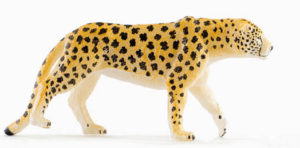Prehistoric Cheetah Skull found in Asia
A prehistoric cheetah skull found in Asia re-writes the evolution of these big cats. The origins of the big cats of today, the lions, tigers, pumas and cheetahs for example, are shrouded in mystery. It had been thought that the modern cheetah Acinonyx jubatus had originated from North America (known as the new world), but now fossil evidence unearthed in China indicates that these felines may have evolved in Asia.
Prehistoric Cheetah Skull
The fossil record of large feline predators is extremely sparse. There are several reasons for this, firstly, as animals at the top of the food chain there are fewer of them compared to the herbivores and omnivores in any habitat, so the chance of any remains becoming fossilised is statistically less likely. Also, most of the big cats live in areas such as jungle or savannah and these habitats provide very few opportunities for effective fossilisation to take place, so big cat fossils are very rare. Finding a skull or teeth is a huge prize for palaeontologists when it comes to piecing together the relationships between various extinct species of large cat. It is the skull morphology and the teeth that can be most helpful in determining the relationships between different genera.
A modern Cheetah (Acinonyx jubatus)
A team of Chinese scientists have announced the discovery of the oldest fossil of a new species of cheetah. This discovery would indicate that cheetahs originated in Asia and not in North America as previously thought. Researchers found a partial cranium and some teeth in the Gansu Province of north-west China. It is similar in size and shape to the skulls of modern cheetahs, but the teeth are much more primitive.
In a paper published by scientists from the Shanghai Science and Technology Museum, this fossil represents an early stage in the evolution of these big cats. The new species of cheetah has been named Acinonyx kurteni. In prehistoric times, the big cat species were much more widespread, with cheetahs roaming Europe, Asia, India and North America. Fossils of cheetahs found in various parts of the world have intrigued scientists as they try to calculate the site of the earliest fossils and hence the origins of this particular big cat family.
The newly studied fossils were dated to the Late Pliocene, between 2.15 and 2.55 million years ago. Although, not the oldest cheetah fossils known, this new discovery challenges the accepted theory that the cheetahs originated in the Americas.
Prehistoric Cheetahs of North America
Two prehistoric cheetah-like species of North America are believed by some scientists to be distant cousins of giant cheetahs of ancient Europe. In North America, up until the end of the Pleistocene period, large cheetahs hunted on the plains (Miracinonyx).
To read more about the mega fauna of North America: The Bison – a Contributor to Mammoth Extinction.
This possible relationship has led some scientists to suggest that the earliest cheetahs may have originated in North America and travelled across the Bering Strait from Alaska to Siberia, during a period of falling sea levels, when a land bridge between Asia and the Americas was formed.
This new find challenges this theory, the skull and teeth from China indicate a Eurasian/African origin of the cheetah family. For instance, the primitive dental features would have been more developed in the Chinese fossil if cheetahs had come from North America. The research paper supports the theory that the big cats originated in the old world and not the new world of the Americas.
Eveything Dinosaur stocks a range of prehistoric mammal models including replicas of big carnivores: Replicas of Prehistoric Mammals.







Leave A Comment